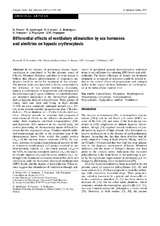Mostrar el registro sencillo del ítem
Differential effects of ventilatory stimulation by sex hormones and almitrine on hypoxic erythrocytosis
| dc.contributor.author | Favier, R | |
| dc.contributor.author | Spielvogel, Hilde | |
| dc.contributor.author | Cáceres, E | |
| dc.contributor.author | Rodríguez, A | |
| dc.contributor.author | Sempore, B | |
| dc.contributor.author | Pequignot, J | |
| dc.contributor.author | Pequignot, JM | |
| dc.date.accessioned | 2017-03-24T18:14:25Z | |
| dc.date.available | 2017-03-24T18:14:25Z | |
| dc.date.issued | 1997 | |
| dc.identifier.uri | http://repositorio.umsa.bo/xmlui/handle/123456789/9877 | |
| dc.description.abstract | Abstract. In the absence of pulmonary disease, hypoventilation is considered to be the primary cause of Chronic Mountain Sickness, and there is some reason to believe that chronic administration of respiratory analeptics could be useful for treatment of this disease. The present study was intended to define comparatively the influence of two potent ventilatory stimulants, namely a combination of progesterone and estrogen and the pharmacological agent almitrine, on catecholaminergic structures implicated in the chemoreflex pathway and on hypoxia-induced polycythemia. Three groups of young male rats born and living at high altitude (3 600 m) were examined: untreated animals (n = 25), rats given ovarian steroids (progesterone plus 17β-estradiol, n = 25) or almitrine (n = 25) for 6 weeks until sacrifice. Ovarian steroids or almitrine had pronounced neurochemical effects on the afferent chemoreflex circuitry. Both treatments inhibited norepinephrine (NE) and dopamine (DA) turnover in the carotid body, but central processing of chemosensory inputs differed between the two respiratory drugs. Ovarian steroids inhibited noradrenergic activity in the projection area of the chemosensory nerve fibers within the caudal portion (A2C) of the nucleus tractus solitarius (NTS). In contrast, almitrine stimulated neurochemical activity of other brainstem noradrenergic cell groups involved in cardiorespiratory control, i.e., the rostral portion (A2R) of the NTS, the nucleus reticularis lateralis (A1), the nucleus olivaris superior (A5) and the locus ceruleus (A6). Although both treatments increased chemoreflex drive and ventilation, only sex hormones decreased erythropoietin (EPO) levels and the degree of polycythemia. These results suggest that stimulation of ventilation through activation of peripheral arterial chemoreceptors activation alone is not sufficient for reducing EPO levels and polycythemia. The better efficiency of female sex hormone treatment as compared to almitrine could be related either to the central effects of progesterone and estrogen and/or to the impact of these hormones on erythropoiesis at the kidney/bone marrow level. | es_ES |
| dc.language.iso | en | es_ES |
| dc.publisher | Pflugers Arch-Eur J Physiol | es_ES |
| dc.subject | CUERPO CAROTÍDEO | es_ES |
| dc.subject | POLICITEMIA | es_ES |
| dc.subject | DOPAMINA | es_ES |
| dc.subject | NORADRENÉRGICO | es_ES |
| dc.title | Differential effects of ventilatory stimulation by sex hormones and almitrine on hypoxic erythrocytosis | es_ES |
| dc.type | Article | es_ES |

